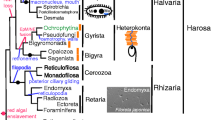Abstract
Oocytes of hymenopterans are equipped with peculiar organelles termed accessory nuclei. These organelles originate from the germinal vesicle (oocyte nucleus) and gather preferentially at the anterior pole. To gain insight into the mechanism of uneven (asymmetrical) distribution of accessory nuclei, the organization of the microtubule cytoskeleton in the oocytes of two hymenopterans Chrysis ignita and Cosmoconus meridionator has been studied. It is shown that during late previtellogenesis two networks of microtubules are present along the contact zone between the oocyte and enveloping follicular epithelium. The external one is associated with belt desmosomes connecting neighbouring follicular cells. The internal network is composed of randomly orientated microtubules and separates transparent, organelle-free periplasm from the endoplasm. All cellular organelles and the germinal vesicle are localized in the endoplasm. Accessory nuclei are accumulated in the anterior endoplasm; they always lie in direct contact with the subcortical network. Treatment with colchicine results in the disappearance of the periplasm as well as in the redistribution of cellular organelles including accessory nuclei. Presented findings suggest that subcortical microtubules play an important role in the positioning of accessory nuclei throughout the ooplasm.
Similar content being viewed by others
References
Bilinski SM (1989) Formation and function of accessory nuclei in the oocytes of the bird louse, Eomenacanthus stramineus (Insecta, Mallophaga): I. Ultrastructural studies. Chromosoma 97:321–326
Biliński SM (1991a) Are accessory nuclei involved in the establishment of developmental gradients in hymenopteran oocytes? Ultrastructural studies. Roux's Arch Dev Biol 199: 423–426
Biliński SM (1991b) Morphological markers of anteroposterior and dorsoventral polarity in developing oocytes of the hymenopteran Cosmoconus meridionator (Ichneumonidae). Roux's Arch Dev Biol 200:330–335
Biliński SM, Klag J, Kubrakiewicz J (1993) Morphogenesis of accessory nuclei during final stages of oogenesis in Cosmoconus meridionator (Hymenoptera: Ichneumonidae). Roux's Arch Dev Biol 203:100–103
Büning J (1993) Germ cell cluster formation in insect ovaries. Int J Insect Morphol Embryol 2:237–253
Cassidy JD, King RC (1972) Ovarian development in Habrobracon juglandis (Ashmead) (Hymenoptera: Braconidae): I. The origin and differentiation of the oocyte-nurse cell complex. Biol Bull 143:483–505
Clark I, Giniger E, Ruohola-Baker H, Jan LY, Jan, Y-N (1994) Transient posterior localization of a kinesin fusion protein reflects anteroposterior polarity of the Drosophila oocyte. Curr Biology 4:289–300
Cooley L, Theurkauf WE (1994) Cytoskeletal functions during Drosophila oogenesis. Science 266:590–596
Ding D, Lipshitz HD (1993) Localized RNA's and their functions. BioEssays 15:651–658
Gutzeit HO (1985) Oosome formation during in vitro oogenesis in Bradysia tritici (syn. Sciara ocellaris). Roux's Arch Dev Biol 194:404–410
Gutzeit HO (1986a) The role of microtubules in the differentiation of ovarian follicles during vitellogenesis in Drosophila. Roux's Arch Dev Biol 195:173–181
Gutzeit HO (1986b) The role of microfilaments in cytoplasmic streaming in Drosophila follicles. J Cell Sci 80:159–169
King PE, Fordy MR (1970) The formation of accessory nuclei in the developing oocytes of the parasitoid hymenopterans Ophion luteus (L.) and Apanteles glomeratus (L.). Z. Zellforsch 109:58–170
Klag J, Biliński SM (1994) Germ cell cluster formation and oogenesis in the hymenopteran Coleocentrotus soldanskii. Tissue Cell 26:699–706
Mahajan-Miklos S, Cooley L (1994) Intercellular cytoplasm transport during Drosophila oogenesis. Dev Biol 165:336–351
McPherson SMG, Huebner E (1993) Dynamics of the oocyte cortical cytoskeleton during oogenesis in Rhodnius prolixus. Tissue Cell 25:399–421
Meyer GF, Sokoloff S, Wolf BE, Brand B (1979) Accessory nuclei (nuclear membrane baloons) in the oocytes of the dipteran Phryne. Chromosoma 75:89–99
Neuman-Silberberg FS, Schupbach T (1993)The Drosophila dorsoventral patterning gene gurken produces a dorsally localized RNA and encodes a TGFα-like protein. Cell 75:165–174
Nusslein-Volhard C (1991) Determination of the embryonic axes of Drosophila. Development Suppl 1:1–10
Pokrywka NJ, Stephenson EC (1991) Microtubules mediate the localization of bicoid RNA during Drosophila oogenesis. Development 113:55–66
Pokrywka NJ, Stephenson EC (1994) Localized RNAs are enriched in cytoskeletal extracts of Drosophila oocytes. Dev Biol 166:210–219
St Johnston D (1993) Getting to the top. Curr Biol 4:54–56
St Johnston D, Nüsslein-Volhard C (1992) The origin of pattern and polarity in the Drosophila embryo. Cell 68:201–219
Stys P, Biliński SM (1990) Ovariole types and the phylogeny of hexapods. Biol Rev 65:401–429
Szklarzewicz T, Biliński SM, Klag J, Jablonska A (1993) Accessory nuclei in the oocytes of the cockoo wasp, Chrysis ignita (Hymenoptera: Aculeata). Folia Histochem Cytobiol 31: 227–231
Theurkauf WE, Smiley S, Wong ML, Alberts BM (1992) Reorganization of the cytoskeleton during Drosophila oogenesis: implications for axis specification and intercellular transport. Development 115:923–936
Theurkauf WE, Alberts BM, Jan Y -N, Jongens TA (1993) A central role for microtubules in the differentiation of Drosophila oocytes. Development 118:1169–1180
Watson CA, Sauman I, Berry SJ (1993) Actin is major structural functional element of the egg cortex of giant silkmoth during oogenesis. Dev Biol 155:315–323
Wilhelm JE, Vale RD (1993) RNA on the move: the mRNA localization pathway. J Cell Biol 123:269–274
Zissler D (1992) From egg to pole cells: ultrastructural aspects of early cleavage and germ cell determination in insects. Microsc Res Tech 22:49–74
Zissler D, Sander K (1982) The cytoplasmic architecture of the insect egg cell. In: King RC, Akai H (eds) Insect ultrastructure, vol 1. Plenum Press, New York, pp 189–221
Author information
Authors and Affiliations
Rights and permissions
About this article
Cite this article
Biliński, S.M., Klag, J. & Kubrakiewicz, J. Subcortical microtubule network separates the periplasm from the endoplasm and is responsible for maintaining the position of accessory nuclei in hymenopteran oocytes. Roux's Arch Dev Biol 205, 54–61 (1995). https://doi.org/10.1007/BF00188843
Received:
Accepted:
Issue Date:
DOI: https://doi.org/10.1007/BF00188843




